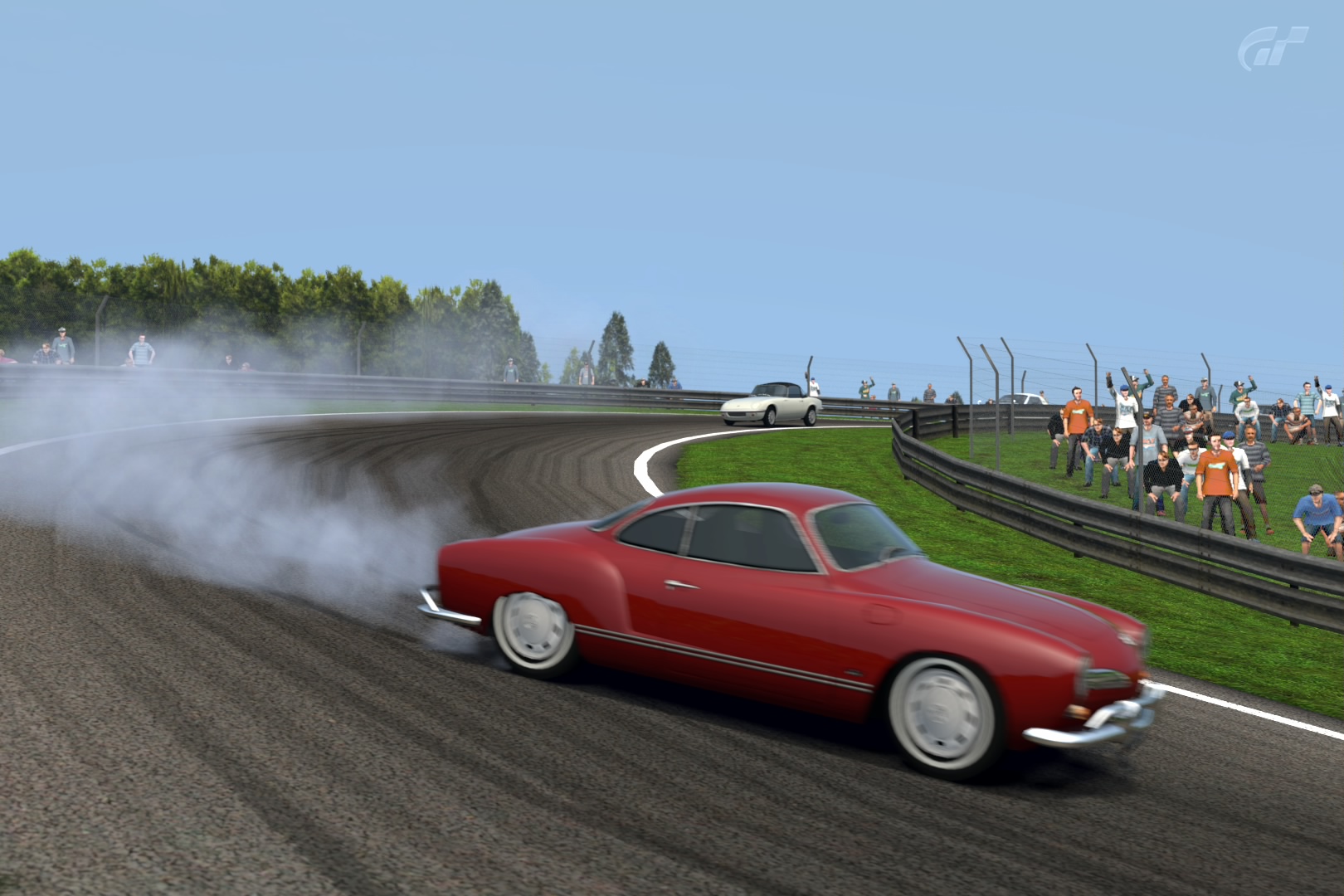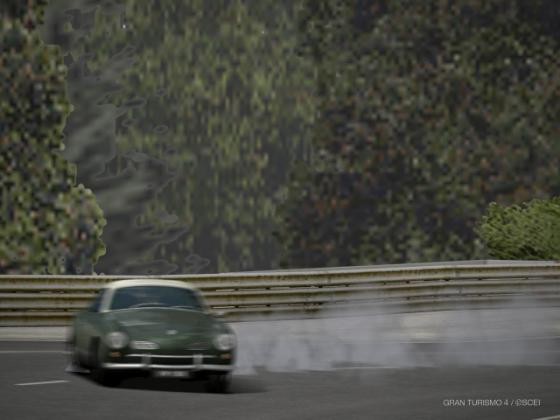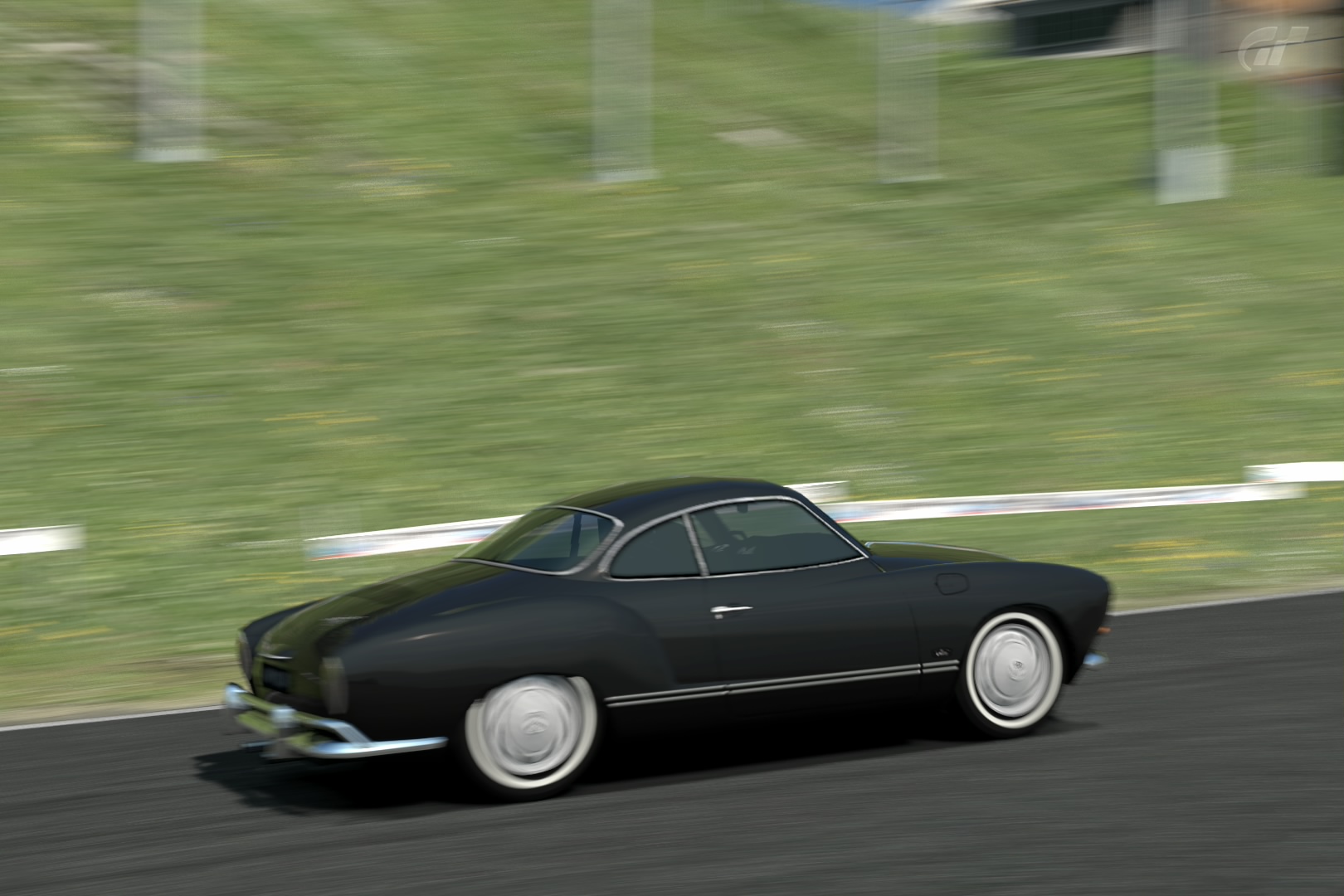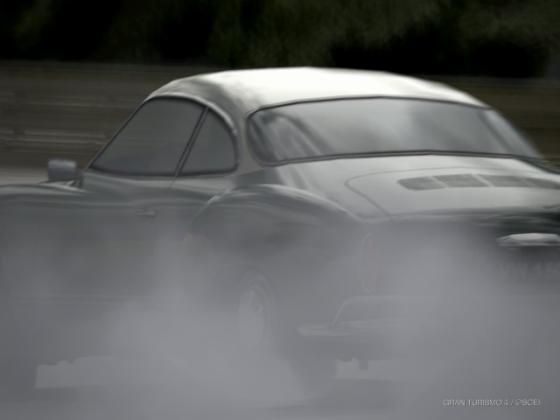|
SPEX
Year Represented: 1968
Host: GT4 & GT5
Class: Sports Compact
Type:
2-seat coupe
Country: Germany
Price: $18,019 (GT4: trade after winning as prize)
``````````$11,867
(GT5 used car lot)
Length: 163.0" // Width: 64.3" // Height: 52.4"
Wheelbase: 94.5"
Overhang: @5 feet 9
inches
Track: 53.1" [F] 51.2" [R]
Ground Clearance: 6.3"
Weight: 1,851 pounds
Steering: unassisted worm &
sector
Layout: Rear Engine / Rear Drive
Tires: 5.60 x 15"
F. Suspension: transverse torsion bars, upr & lwr trailing
arms
R. Suspension: swing axle, trailing arms, torsion bars
Brakes: solid discs / drums
Engine:
1.5 liter OHV Flat-4
Construction: cast iron
Aspiration: natural
Fuel System: 1 single-barrel carburetor
Valves
/ Cyl: 2
Bore x Stroke: 3.27 x 2.72"
Compression: 7.5:1
*oil change (but no other maintenance) was completed
for the car in GT5.
````````````````````````GT4``````````````````````````````GT5`````````
Final
BHP: 46 @ 4,000 rpm 42 @ 4,000
Fnl Torque:
73 @ 2,000 rpm 72 @ 2,000
Credits
per HP: $391.71
$281.12
Pounds per HP: 40.24
44.07
HP per Liter: ````30.8
GT4 Idle Speed: 550 // Redline: 4,550 // RPM Limit: 5,000
GT5 Idle Speed: 625 // Redline: 4,500 // RPM Limit:
5,000
``````````````````````GT4```````````````````````````````GT5```````
0-60 mph: 18.350 seconds
19.493 seconds
0-100 mph: Nil
Nil
400 M: 21.708 @ 64 mph 22.012 @
63 mph
1 Kilomtr: 39.797 @ 81 mph 40.545
@ 79 mph
Test Track Lap: No Test
1:37.011 (Daytona)
Brakes 100-zero mph: Nil
Top Gear RPM @ 60 mph: 2,800
Top Speed at Redline
1st:
20.2 mph
2nd: 39.8 mph
3rd: 65.5 mph
4th: 94.77 mph @ 4,550 rpm (GT4)
92.50 mph @ 4,500 rpm (GT5)

--------------EXTERIOR / HISTORY----------
Here's a car I never even considered would appear in any game, Gran Turismo, Enthusia, or otherwise.
In fact, it takes a bit of imagination to consider how it's even possible the Volkswagen Karmann Ghia could make it as a racing
car. Truth is, it was raced often back in the '60s and '70s on an amateur level, so let's try and see why.
I've
been disappointed with the selection of Beetles in Gran Turismo; I feel there aren't enough older ones available, considering
there were subtle style differences from the '40s to the '70s, as well as many different engine sizes. So the Karmann Ghia,
which can be won as a prize in GT4 but bought from the used car lot in GT5, was a shocker to find. Its price
is never too great, either, whether we buy it in GT5 or trade it in GT4.
When I was a kid, my next
door neighbor had two Volkswagens: a red Beetle convertible and an orange & white VW Bus. I have a
vague memory of this guy, a dad with two kids, and how he aspired to someday own a Karmann Ghia. Back then, I
knew little about any of these models (other than the fact that they had noisy air-cooled engines), but recently I have
become more educated.
The model that started it all was the VW Beetle, of course. Actually, that's basically
incorrect. Originally, and for many years, the Beetle was simply known as the Type 1. The
words "Beetle" and "Bug" were nicknames created by American advertisers during the late '60s. So
the Type 1 was created, in fact, with a go-ahead during Adolf Hitler's regime as a car for everyday
people, who needed everyday transport. As a fascist country, Germany at the time basically had a neo-socialist class
structure, which means the "common" people were more or less supposed to be equal, with your chances of "getting
ahead" in society just about nil. The Beetle was perfect since it was uncomplicated, low-powered, utilitarian, easy
to repair, could be mass-produced like pizza, yet possesed an oddly eye-catching style...a flair which seems out-of-place
with German ideals of the time.
For all these reasons, Type 1s sold in droves, and were eventually exported
all over the world. Was this part of Hitler's plan? Somehow I doubt it. I'm glad it was Volkswagen's plan, though. Anyways,
after millions sold, the public demanded something more. Now that the Type 1 was being sold to many markets that
were not socialist, where it had actual competition, Volkswagen wanted to capture a larger market, and started
in 1953 with their Karmann Ghia.
Some car-makers we know nothing about (in smaller, poorer socialist or communist
countries for instance) have been making the same models for decades because there is no demand, no immediate need
for anything else. The Development cash for something new doesn't exist in many cases, and many of these
developing or third-world models are often rebadged models from first-world countries. The Yugoslavian Zastava 750,
which was a rebadged Fiat 500, makes a good example. Volkswagen could have fallen into this trap, making just a single
model for years (since sales were high) but wisely chose not to.
The Karmann Ghia was shown at the 1953 Paris
Auto Show and caused a big stir. Its odd name is the result of two entities working in tandem: Karmann was the coach-builder
VW commisioned to mass-produce the car, and Ghia was the Italian design house which created its striking
design.
The Karmann Ghia had a hand-built body, something usually only reserved for
low-volume, higher-priced makes, yet amazingly, the K-G was sold in great numbers over the course of its 19-year
life. In its first year, 10,000 examples were out the factory and on the streets. Overall, VW sold 445,000 of these,
finally halting production in 1974 when they released their water-cooled Scirocco. Several versions of the Karmann Ghia were
created over the years, and Gran Turismo 4 and 5 both have the 1500 coupe, rather than one of the earlier Karmann
Ghias, which believe it or not were probably even slower than the car in our game!
It's
a lightweight, of course. Despite the fact that it's just 1,851 pounds and was considered a "sports
car", there aren't many avenues we'll be able to take our Karmann Ghia as a race car.

--------------ENGINE / DRIVETRAIN-----------
So let's start with the word "why". And the answer is immediately obvious: just 44 horses,
46 after oil-change! That's GT4. GT5 is a little less than this, since these are used cars in this game.
It's
a shame PD didn't include the 1600 model (rather than the 1500 in our game). The 1600 had a 1.6 liter engine which boasted
a staggering 60 horsepower. At least that's a better start than 44, wouldn't you agree?
Upgrades are odd in GT4.
We have three naturally-aspirated kits, which means it's possible to replace everything in real-life:
cams, pistons, crank, etc. with more capable parts. This is highly realistic since VW Bugs & Karmann Ghias were heavily
raced and developed for racing back in the day. We also have one turbo we can buy. Whether we
buy the turbo or the 3rd NA kit, power is still meager: 106 horses with 163 foot-pounds
with full natural power, or 105 horses with 152 foot-pounds with the turbo. The
other two natural-power kits (Stage 1 and Stage 2) aren't necessary buys unless you're trying to compete fairly against
some old slugs or something.
GT5 features all the typical upgrades of the tuning shop: all three turbos + three
permanent upgrades, et cetra. Max power with oil change and engine rebuild takes us to a disappointing 114
horsepower @ 4,700 rpm with 133 foot-pounds of torque at 4,200. And the sad
thing is I did need to spend this cash ;well over 100,000 credits, to make this sort of power. And I did need this
sort of power to complete some of GT5's Beginner Classic Car events!
This is disappointing mostly because
the Volkswagen Bus in the same game can make somewhere around 200 horses, and that's with a smaller 1.2 liter engine!
I'm assuming that the Bus gets more power because that final Stage 3 turbo must be huge, and there's actually
room for it in the cargo area? That's my guess.
Like I said, there's little we can do with these
upgrades. Sunday Cup (obviously), Historic Car Cup, and 1000 Miles! in GT4, and Sunday Cup, European Classics, plus World
Classic Cup Series are the only places the poor K-G can compete at. We must make sure faster cars like the
'63 Corvette Stingray, don't show up on the grid if we do some of those historic events. I'm not sure, but I
think the K-G might be able to compete in the El Capitan and/or Seattle Enduros, too. Maybe, maybe not...I'm not
sure yet. Since this car has a "pancake"/flat engine, it also qualifies for the Pro-League Boxer Engine races, which
you'll only win if you're on acid.
Not much else to say, really. On the plus side, the 1.5 liter air-cooled engine
sounds GREAT. It sounds like PD actually did sample a Volkswagen...not out-of-question since there are still hundreds
of thousands of these around.
The 4-speed gearbox feels tall, but is really a short-throwing box which maxes out at
just over 109 mph with the turbo or 113 with the stage 3 na kit, once you've got upgrades
in place. It only feels tall due to that meager power. Matter of fact, in my track tests, I couldn't get a zero to 100
mph time or a braking time from 100 mph to zero because the poor K-G won't get over 95 mph when stock!
Wow. That
was depressing. Let's move on to the next section.

-------------CHASSIS / HANDLING----------------
Luckily, here's where things really start to get interesting.
The Karmann Ghia suspension is similar to the Beetle...er Type 1 suspension of its time.
Torsion bars (rather than coils), trailing arms, and a rear swing-axle, emphasis on the word "swing.". Only
difference is the Karmann starts with a 12" wider floor pan, with a wider track and longer wheelbase as well. Swing axles
were high technology of the day since they were independent, rather than solid. Though this car handles with more prowess
than a Triumph Spitfire (which also had a swing axle), it is still difficult at times.
But despite its difficult
handling prospects, low power, slow acceleration, and low top speed, the Karmann-Ghia turns out to be a ball
to drive. Lots of fun. Makes me really wish there was more power available.
Mostly, it's fun because it's a rear-engine
car. Its light front-end can be weighted-down with a front-bias ballast if you choose, but otherwise, the rear is where most
of this cars weight, and problems, are located. Unlike some other rear-engine cars, the Karmann Ghia isn't prone to much
understeer; instead, the front-end has a habit of grabbing, which can be just as dangerous as understeer, but
in a different way. Doesn't matter if N tires or Sports tires are being used.
All of this is true in GT4 or GT5, by
the way. GT5's Karmann Ghia feels a little more controllable, even on the car's stock Comfort Medium radials. Steering in
this game isn't quite so grabby. Braking while steering, though, is still something to be avoided big-time, unless
we're just talkin' a minor twitch here and there.
The main diff between GT4 and GT5 is there is certainly more wheelspin
in GT5. Even if we're talking just 80 or 90 horsepower, careful out of those tighter areas because the Karmann Ghia can
smoke up its tires if you're not careful, even in 2nd gear. This is mostly true with Comfort tires, but Sports
can occasionally lose their grip, too. A limited-slip quickly dispels most of this, of course.
To truely master this one (in either game), it's best to keep all your driving habits light,
with the exception of heavy braking before turns and heavy throttle out of them. Mid-corner transitions between throttle,
braking, and steering must be handled with care. For instance, since the front-end locks-in to pavement so well, it doesn't
take much steering input to get it turning. Small flicks of steering are typically all that's needed. It doesn't take
much braking action, either, perhaps because most of the time this car is running so slow. Pounding on those brakes mid-corner
can induce some wicked slides, but even if they're not pounded, the rear tends to exhibit lift-off oversteer, which still
turns into a vague slide. Most of the time, these slides are easily correctable.
Throttle work
mid-corner should also be minimal, if you're trying to get this car to behave, at least. When this one does (and will)
try to get sideways, such motions can be counteracted via countersteer more heavily, but usually it doesn't take
much time to get the K-G out of a slide. Some folk may try and kill all of this behavior with a limited-slip, but personally,
I'm an open-diff guy with this car. It's not a horribly handing machine, it's just somewhat tempermental.
If there
were more power, a limited-slip would quickly become a necessity. More power would introduce the possibility of less
traction with throttle-induced jackknives being the end result, and the Karmann Ghia would quickly go from being a fun
pal to play around with to a maddening driving experience. Maybe it's best that things are kept the way they are.
PROS------------------------------------------
1). Striking,
good-looking design! I can't help but watch all my replays of this car (even the bad ones) since I love watching it!
2).
That wheezy, air-cooled, flat engine sound. Like no other. GT5's aftermarket exhausts actually sound as if somebody used a
VW flat-4 for all three soundbytes, too (Sports, Semi-racing and Racing).
3). Some engine upgrades (including a turbo
and 3 NA kits) available.
4). Minimal understeer. Rear-engine cars in our games sometimes understeer heavily while
under pressure. Not this one.
5). Swinger-style maneuverability is alot of fun if you're looking for such behavior.
At full speeds, the sense of danger while driving a Karmann Ghia sometimes outpaces all its faults. Those who are skilled
can use this car's rear-end swinging to eat others alive in those tighter areas.
6). Light on that fuel. I just did
a full lap and a quarter at Nurburgring before a bar of fuel finally disappeared from the meter (in GT4).
7).
This car only can be had in five colors, yet they range from dark green to sky blue to a '60s-era acid orange. Few will
be asking for more.
8). If we put N tires on, it switches from blackwalls to whitewalls.++
9). GT5: all
three turbos can be had, along with a slew of other power options.
10). Inexpensive for a vintage machine.
CONS---------------------------------------
1). No power.
2). No
acceleration.
3). Can't make 100 mph when stock. With full upgrades, it still struggles to get there. Many upgrades
(like crankshaft balancing) cost lots of credits, yet add just a horse or 2 or 3. This is true in GT4 or GT5.
4).
And once it's there, 4-speed gearbox maxes at 109 mph (turbo) or 113 (#3 NA tuning).
Racing tranny needed if you want to get just a little faster, yet this car WON'T get much faster than this
during races.
5). 4,500 rpm redline. Not that this engine needs much more.
6). Oversteer. Rear
slides happen frequently. Though an intuitive driver will find they are easily correctable, the damage is quickly done,
as this car struggles to regain speed.
7). Noisy. I like it, but some others don't.
8). Vague but grabby
steering, which actually causes oversteer if you're not careful. A limited-slip is needed, perhaps.
9). The
front-end also has a habit of bouncing over bumpy areas, damaging steering input at times.
10) Hungry for rear-tire
meat, especially during the 1000 Miles events (GT4), which creates a need for earlier pitstops than we'd like.
11).
Just a few races this one can safely compete at, since the K-G is slightly too long (just over 4,000 mm, again in
GT4) to qualify for Compact Car races, where it belongs. GT5's rules aren't as strict in this regard, so we've got a longer
career ahead of us here.
12). No passenger side mirror.
13). Must be won as a prize in GT4, rather than
bought from the historic lot. Arguably, this car doesn't make much of a prize (other than its classic looks).
Published: November 8, 2008
GT5 Content added: March 5th, 2011
GT5 Testing & misc. edits added:
March 24th, 2013

|



